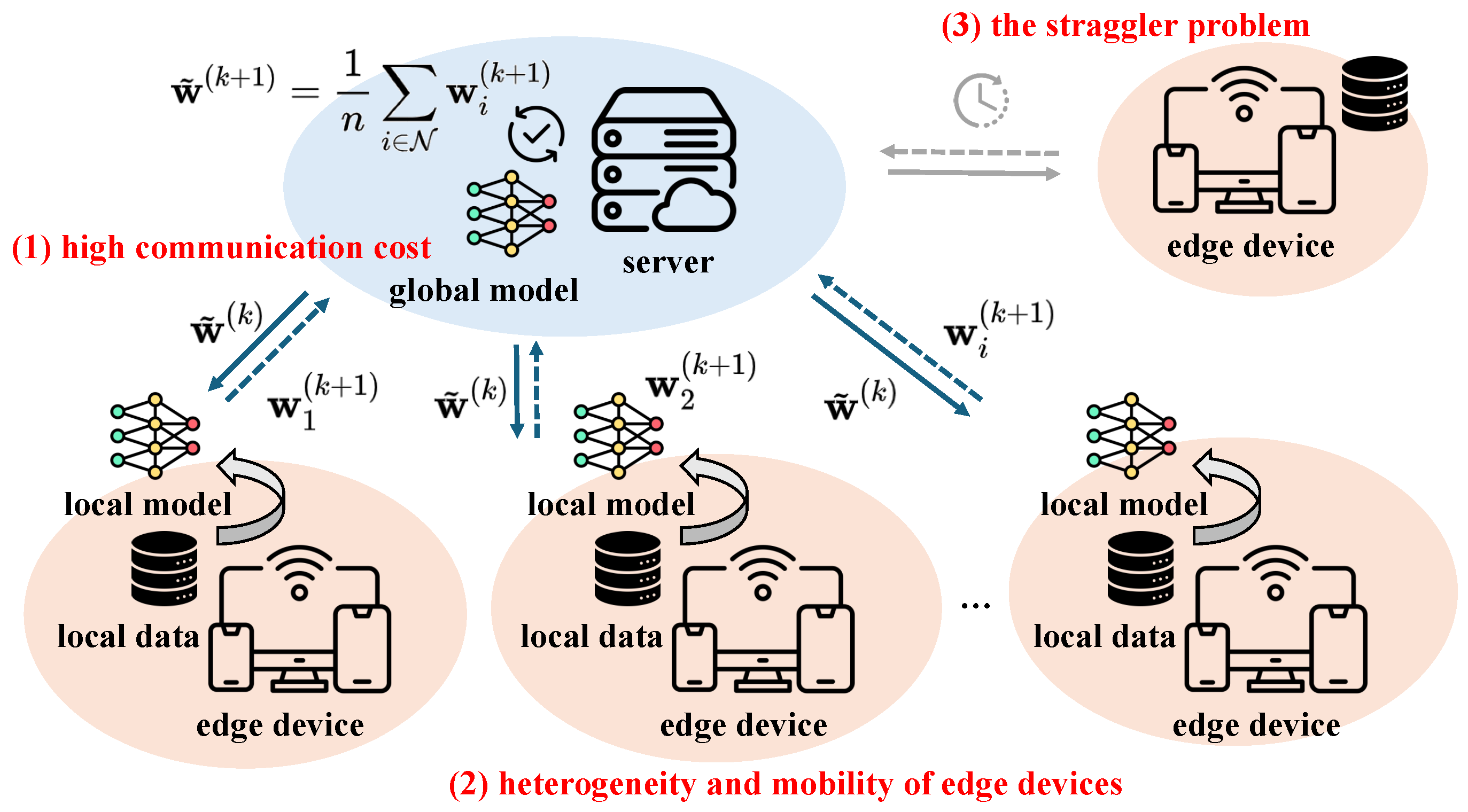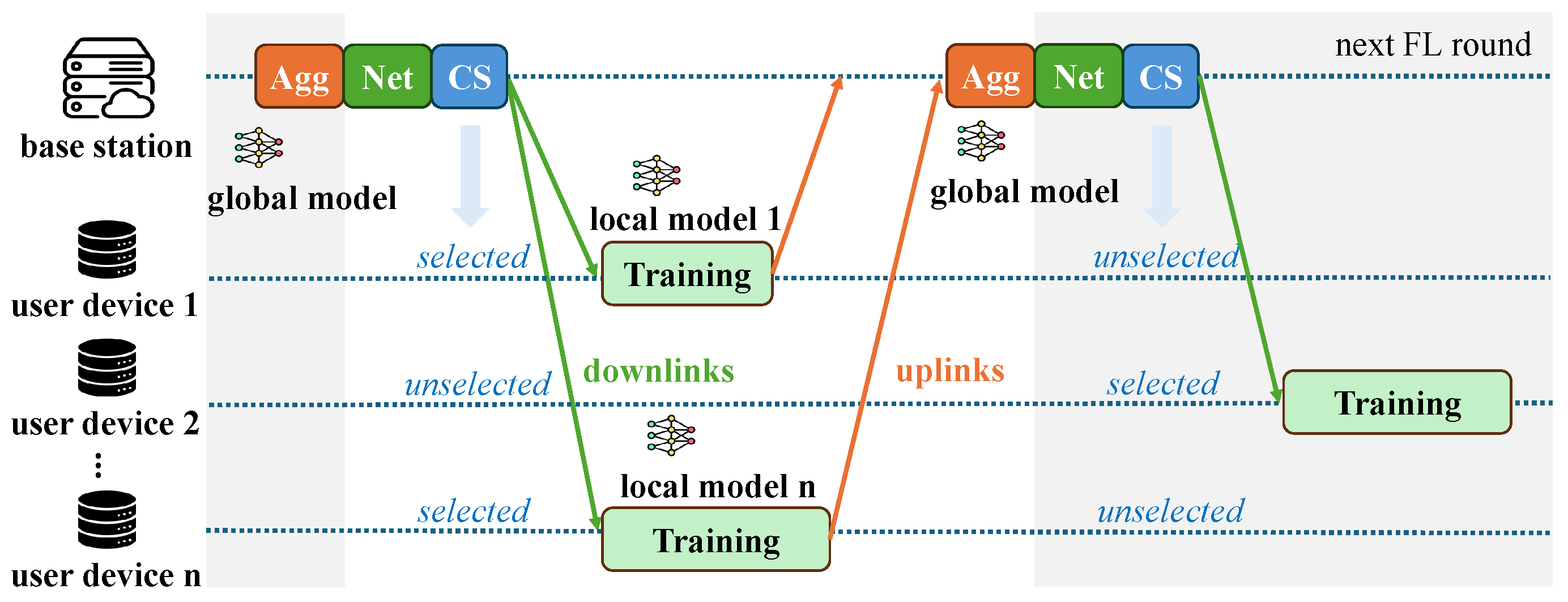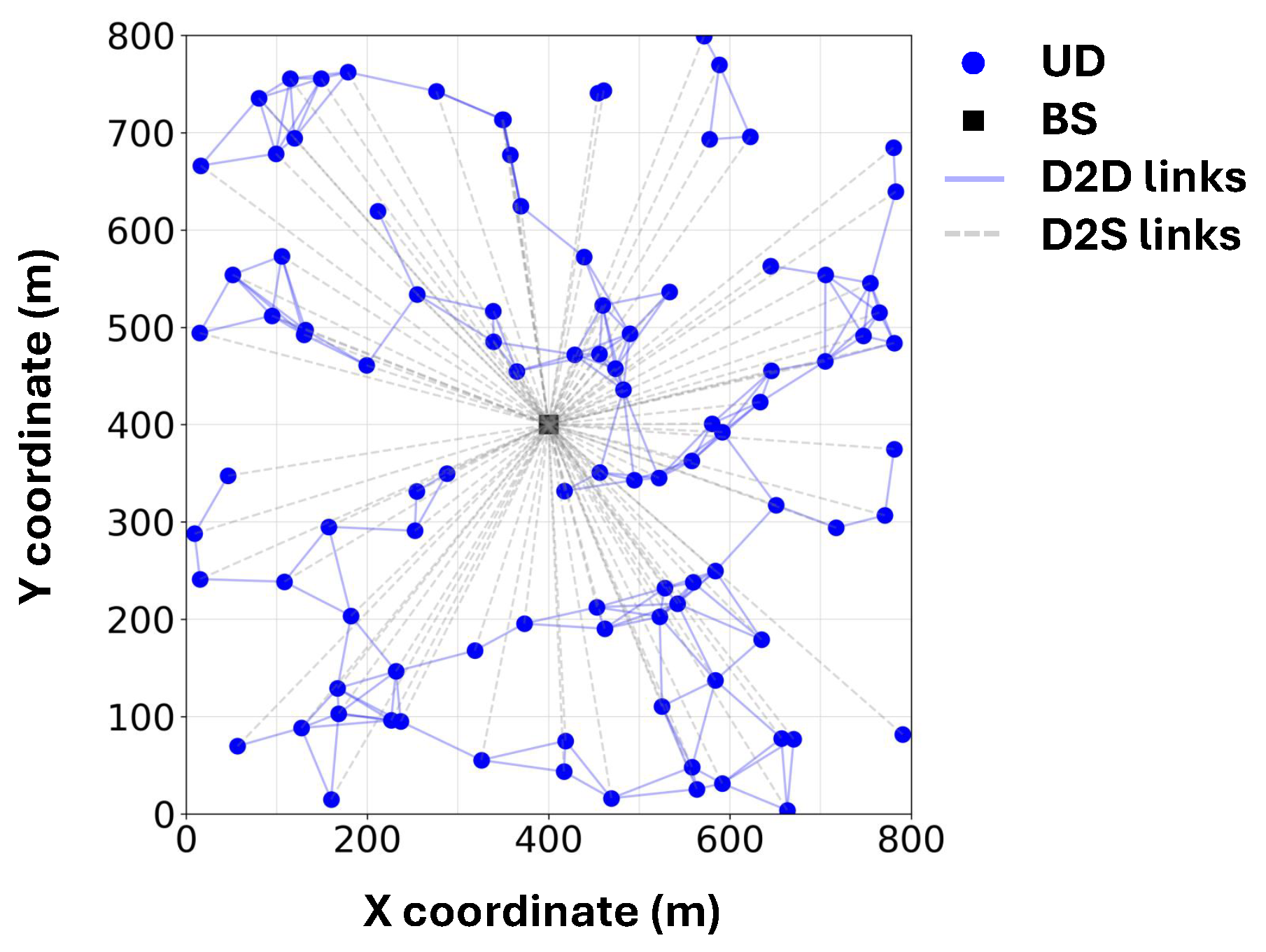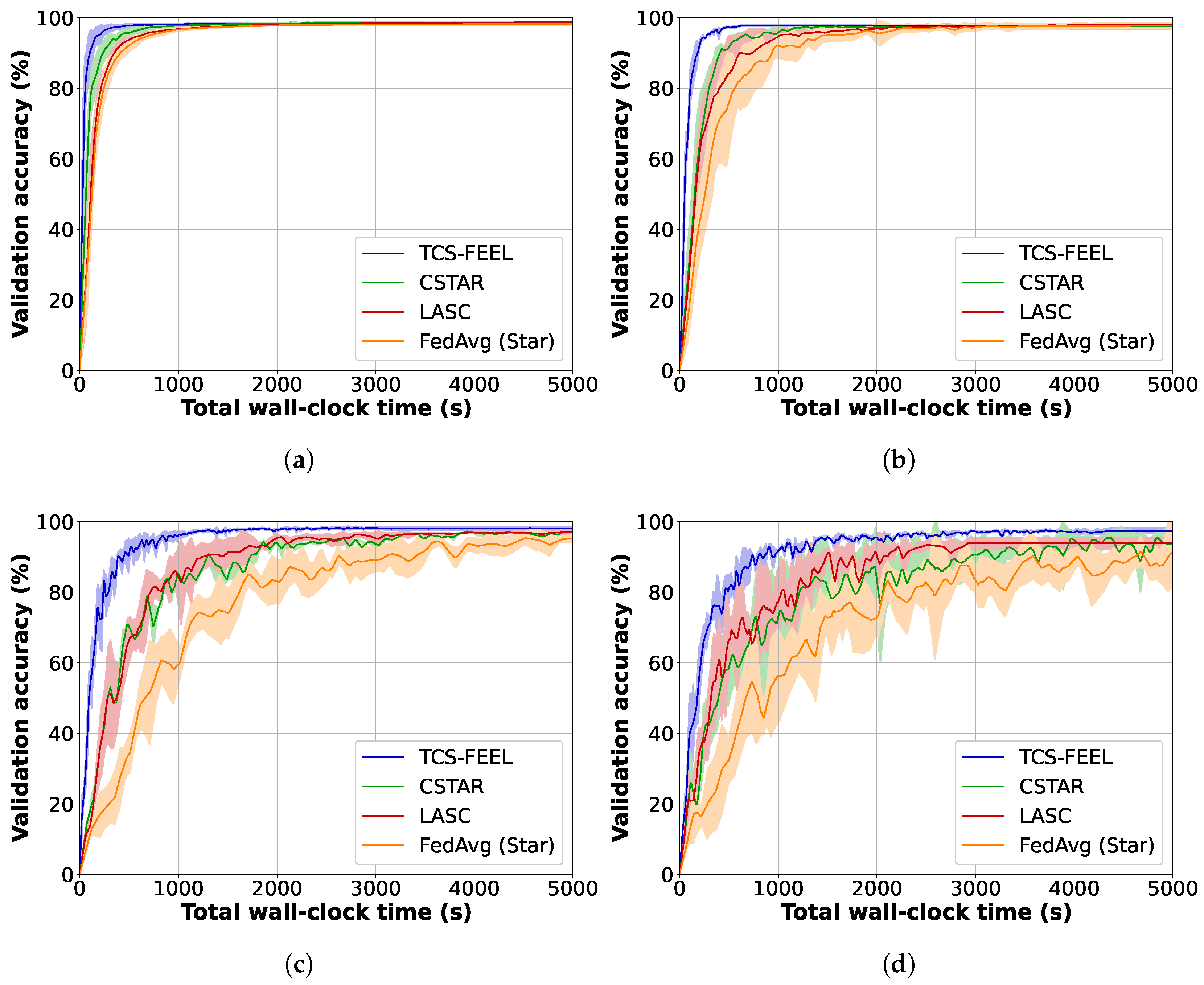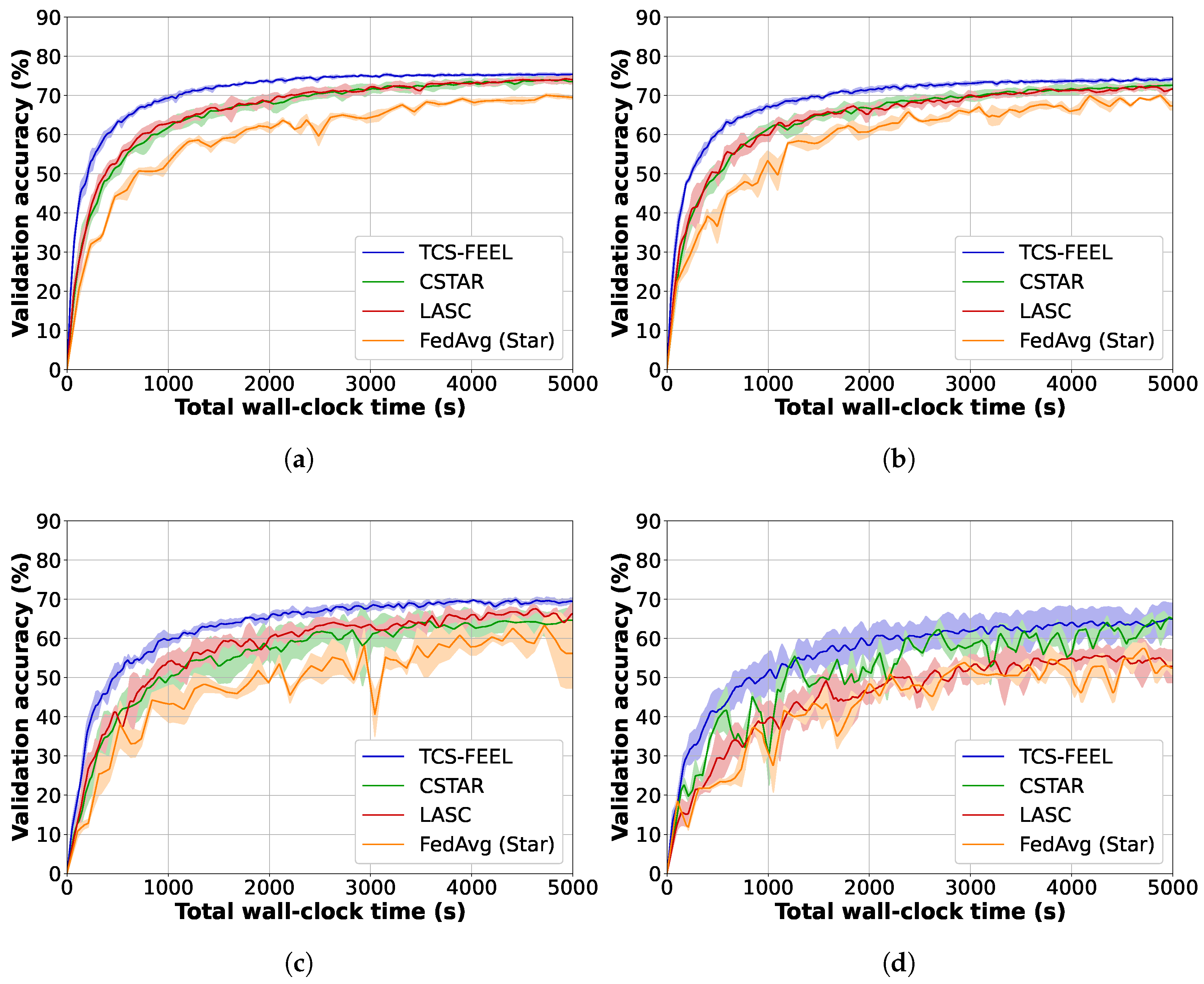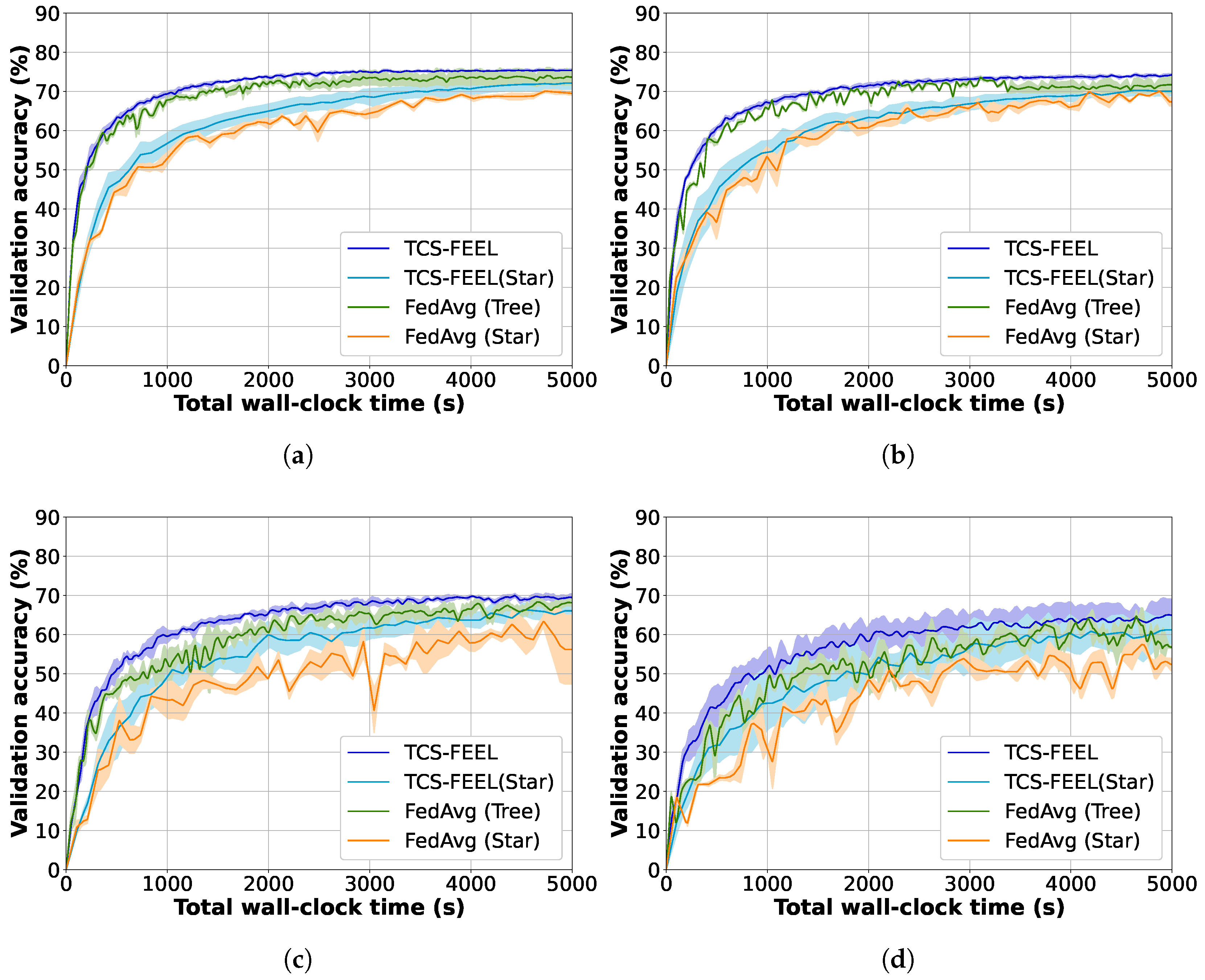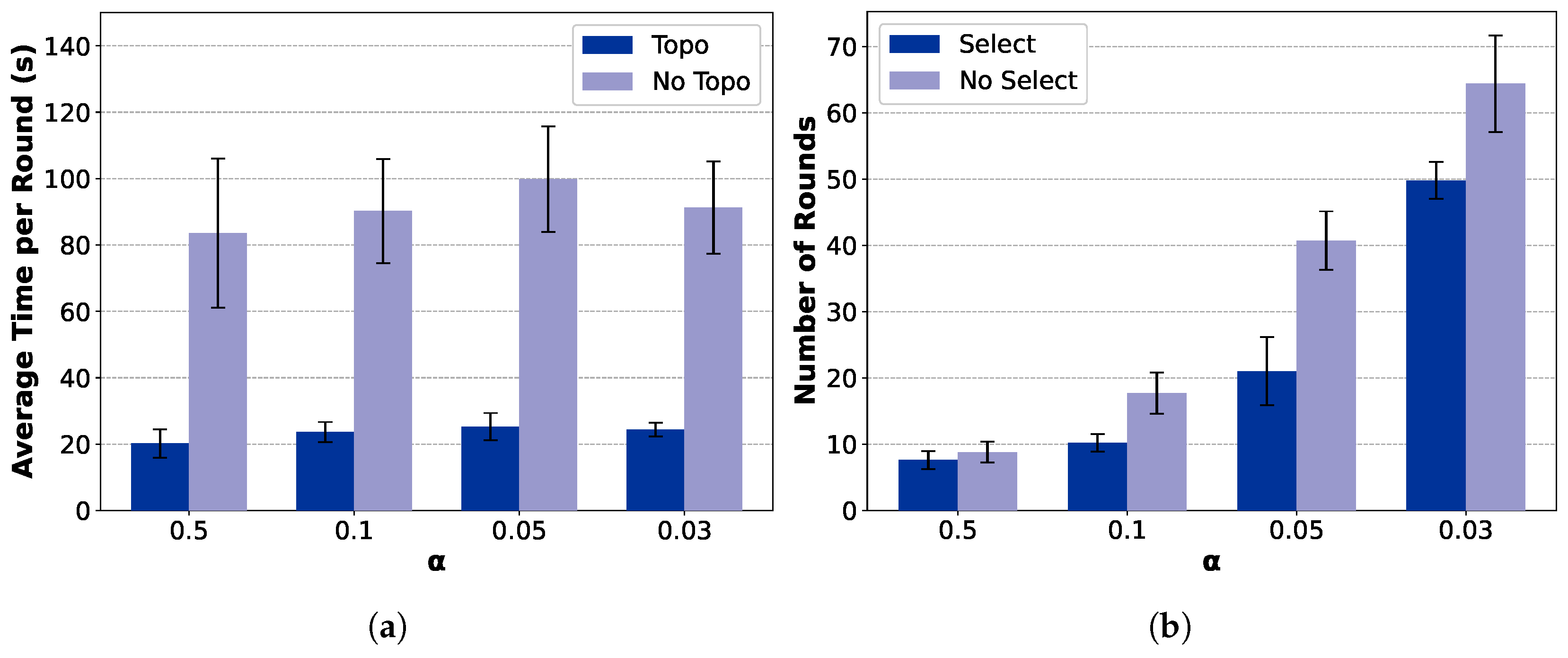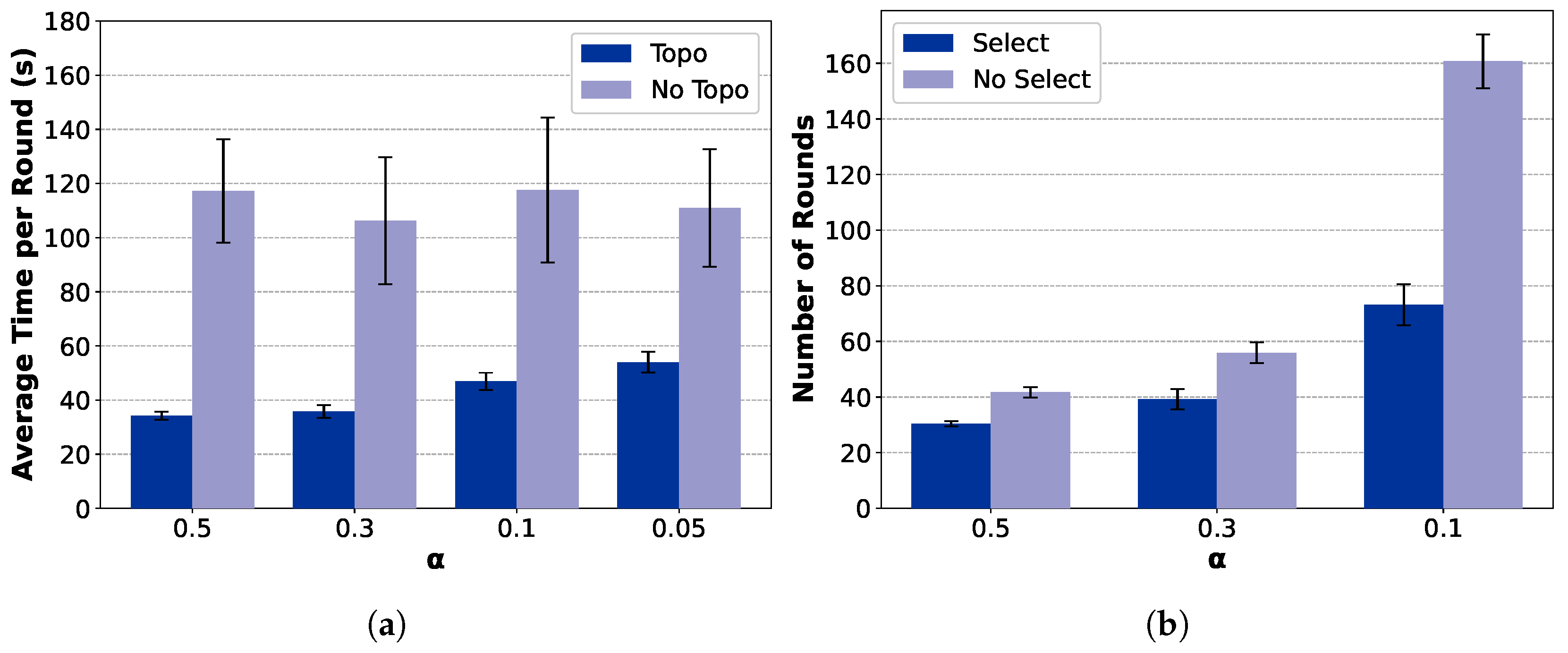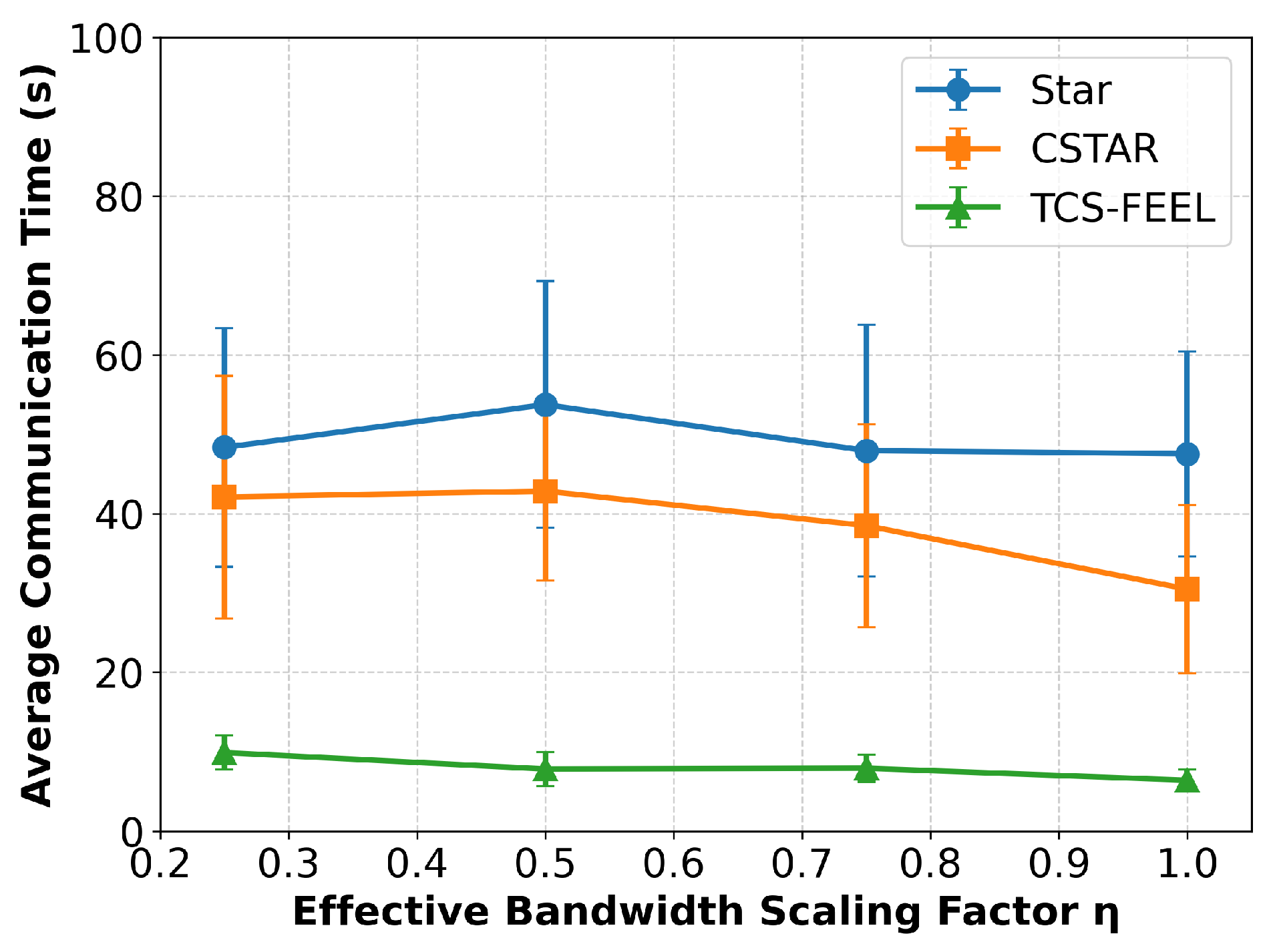1. Introduction
The Internet of Things (IoT) is reshaping the landscape of global connectivity. With the increasing proliferation of interconnected IoT devices, numerous benefits are being introduced into everyday life. The IoT has been widely adopted in diverse domains such as smart homes, smart cities, the Industrial Internet of Things (IIoT) [
1], and smart healthcare [
2]. However, the explosive growth of IoT devices has posed significant challenges to conventional cloud computing paradigms, where vast volumes of raw data have to be transmitted to centralized servers for processing [
3]. This approach has led to substantial latency, congestion, and scalability issues, undermining real-time responsiveness in latency-critical applications.
Edge computing addresses these limitations by processing data closer to their source, thereby significantly reducing latency [
4]. This feature makes it particularly suitable for latency-sensitive IoT scenarios such as virtual reality, augmented reality [
5], and autonomous driving [
6]. In autonomous driving, for instance, real-time obstacle classification on sensor-equipped vehicles imposes stringent computational and communication requirements, necessitating highly efficient distributed intelligence at the network edge. Such edge devices, equipped with heterogeneous sensing and communication capabilities, further emphasize the need for scalable, secure, and resource-efficient distributed learning solutions.
When integrated with the IoT, edge computing offers multiple advantages, including high QoS, low latency, reduced energy consumption, and improved scalability [
7]. However, it also introduces new challenges in terms of privacy and data security, as many devices collect sensitive personal or environmental information. Federated learning (FL) has emerged as a promising distributed intelligence paradigm in this context, enabling collaborative model training directly on devices without sharing raw sensor data [
8]. This property is particularly critical in sensor-based systems such as autonomous vehicles, smart surveillance, and industrial monitoring, where privacy-preserving, real-time intelligence is essential.
Despite these advantages, FL performance in edge environments is often constrained by system heterogeneity (i.e., differences in computing, memory, and bandwidth capabilities) and statistical heterogeneity (i.e., non-identically and independently distributed data) [
9]. System heterogeneity introduces straggler effects, where faster clients idle while waiting for slower ones, while statistical heterogeneity leads to biased global models and slower convergence. Moreover, traditional FL frameworks typically rely on star topologies, where direct device-to-server communication can incur high latency, particularly for resource-constrained or distant devices.
To mitigate these challenges, recent works have explored device-to-device (D2D) communication to complement device-to-server (D2S) links, thereby forming semi-decentralized FL architectures [
10,
11,
12]. D2D communication can reduce energy consumption, enable localized model synchronization, and enhance fault tolerance in dynamic networks—characteristics that are essential to sensor-driven applications with mobile or intermittently connected nodes. Moreover, adaptive topology control further enhances robustness by accommodating device mobility and availability fluctuations [
13].
On the other hand, client sampling strategies that jointly consider statistical and system heterogeneity have been developed to accelerate convergence [
14]. Integrating such strategies with dynamic topology optimization is particularly critical to federated sensor networks, where both communication efficiency and learning performance need to be co-optimized.
Figure 1 illustrates the main challenges in achieving communication-efficient FL in a general mobile edge environment. In this work, we address these challenges by introducing TCS-FEEL, a topology-aware client selection framework specifically designed for sensor-driven federated edge learning. By jointly optimizing communication topology and client selection, TCS-FEEL enables secure, low-latency, and resource-efficient collaborative intelligence directly at the sensing edge. This contribution closely aligns with the goals of sensor-based computational intelligence by facilitating privacy-preserving, adaptive, and scalable machine learning across distributed sensor networks.
For example, in autonomous driving scenarios, real-time obstacle classification tasks performed by on-vehicle edge devices involve substantial computational demand and require frequent model updates to adapt to rapidly changing environments. FL in such settings faces unique challenges, including dynamic topology changes resulting from high mobility and scenario-dependent non-IID data distributions. Therefore, the design of an efficient communication topology is essential to supporting such real-world applications, as it can significantly reduce communication latency, accelerate model updates, and ensure reliable coordination among mobile devices. The proposed TCS-FEEL framework is specifically designed to address these challenges by jointly optimizing communication topology and client selection, thereby enabling more efficient and robust FL in highly dynamic and heterogeneous environments.
In summary, the key contributions of this paper are as follows:
We propose a topology-aware FL framework that leverages D2D communication to dynamically construct tree-based topologies, thereby reducing model transmission latency and improving communication efficiency. Furthermore, we develop a low-complexity algorithm to efficiently solve the topology optimization problem.
We design a stochastic client selection strategy that evaluates client importance by jointly considering data volume, statistical distribution, and communication delay, effectively mitigating the adverse effects of non-IID data on convergence performance.
We conduct extensive simulations in dynamic wireless edge networks with heterogeneous data distributions. The results demonstrate that the proposed TCS-FEEL framework achieves faster convergence and significantly lower communication time compared with state-of-the-art approaches.
The remainder of this paper is organized as follows:
Section 2 reviews the related work.
Section 3 introduces the system model, including the FL objective and the considered network model.
Section 4 presents the proposed TCS-FEEL framework, formulates the optimization objective, and describes the integration of stochastic client selection and dynamic tree topology.
Section 5 details the Monte Carlo-based Gradient Descent (MCGD) algorithm for solving the client selection problem.
Section 6 presents the experimental setup and results, while
Section 7 provides an in-depth discussion of the findings. Finally,
Section 8 concludes the paper and outlines future research directions.
3. System Model
This section presents the system model and key assumptions underlying the proposed TCS-FEEL framework. We consider a federated edge learning scenario consisting of a set of user devices (UDs) and a base station (BS) interconnected via device-to-server (D2S) and device-to-device (D2D) communication links. The proposed model is structured into three core components. Specifically, we first define the FL objective and client sampling mechanism, which govern distributed model training and aggregation across UDs. Next, we introduce the network model, which characterizes communication properties and captures topology dynamics under device mobility. Finally, we present the computation model, which quantifies local training time based on device processing capabilities. Key notations and definitions are summarized in
Table 1.
3.1. Federated Learning Objective
We consider a collaborative learning environment that consists of a set of UDs indexed by and a single BS indexed by . We refer to all UDs and the BS collectively as nodes. Each UD is assumed to store a local dataset of size . Let and denote the feature vector and label of the t-th sample on UD i, respectively, and let represent the model parameters belonging to the parameter space .
We define the
loss function as a function that quantifies the prediction error of a model parameterized by
on sample
t. We define the
local loss on UD
i as the empirical mean of the sample-wise losses:
We define a coefficient that quantifies the proportion of a local dataset size over the global dataset size as
which denotes the relative weight of UD
i’s data in the global dataset. To avoid bias toward UDs with smaller datasets, the FL framework minimizes the following weighted global loss:
All UDs cooperate to learn a single global model
that minimizes the global loss:
Throughout this work, we assume a standard synchronous FL workflow, where each communication round consists of local training on the UDs followed by model aggregation at the BS.
3.2. Client Sampling
In each FL round, only a subset of UDs participate in training. Let
denote the set of UDs selected in round
k. UD
i is independently included with probability
. The sampling process is repeated until
becomes a non-empty subset. Let
The conditional inclusion probability of UD
i is given by
Let
denote the global model available to the UDs at the start of round
k, and let
denote UD
i’s local model after
E local epochs in round
k (initialized from
). The BS updates the global model via inverse-probability weighting:
The factor
ensures unbiasedness with respect to client selection, i.e.,
3.3. Network Model
We consider two communication modes: (i) access links between UDs and the BS, comprising uplink and downlink transmissions, and (ii) D2D links between nearby UDs. To improve reliability and efficiency, we adopt dedicated bandwidth for each mode: Hz for D2D, Hz for uplink, and Hz for downlink. This orthogonal allocation prevents bandwidth contention across communication types and stabilizes channel conditions.
Directed link rates are estimated in each FL round via periodic probe packets. Let denote the measured average throughput of directed link in round k (including D2D links , uplinks , and downlinks ). The BS collects these measurements from UDs and maintains global knowledge of .
At round
k, the network is modeled as a weighted directed graph
where
represents the set of nodes (i.e., the UDs and the BS) and a directed edge
is assigned the latency weight
with
M denoting the model size in bits. We define a directed path from node
i to
j in round
k as a finite ordered sequence of vertices:
Therefore, the transmission time equals the sum of edge weights:
Each UD downloads and uploads the model along the shortest directed paths in . In case multiple shortest paths exist, ties are broken deterministically. First, paths with fewer hops are preferred. If a tie remains, the lexicographically smallest next hop is selected. Under this rule, each node has a unique parent, and the selected paths form a tree topology rooted in the BS.
3.4. Computation Model
In round
k, each UD
performs
E local epochs of mini-batch stochastic gradient descent (SGD) on its dataset
. Let
denote the average processing time per sample on UD
i in round
k. The local training time is
4. Our Framework
Building on the system model defined in
Section 3, we present the design of the proposed TCS-FEEL framework, which aims to minimize the total wall-clock training time by jointly leveraging the latency and computation models as optimization variables. Specifically, the network latency model guides dynamic topology construction, while the computation model informs client selection strategies.
This section is organized as follows: First, we provide an overview of the overall workflow of TCS-FEEL, outlining the key stages of the training and communication process. Next, we describe the optimization of communication topology, which exploits D2D relaying to reduce transmission latency and improve network efficiency. Then, we present the formulation of client selection criteria, which jointly consider system and statistical heterogeneity to accelerate convergence. Finally, we define the overall optimization objective of TCS-FEEL, aiming to minimize the total training time while maintaining high model accuracy.
4.1. Workflow Overview
Figure 2 illustrates the overall workflow of the proposed TCS-FEEL framework. In each FL round, the system dynamically computes the shortest communication paths in real time based on the current network topology and channel conditions, thereby ensuring that routing decisions adapt to mobility and link variations. The overall process is summarized as follows:
The system first performs real-time topology construction by computing the shortest upload and download paths for all UDs based on the current network state. It then calculates their selection probabilities by jointly considering transmission latency, dataset size, and data distribution similarity.
A subset of UDs is sampled according to these probabilities to participate in the current round, with the constraint that at least one UD is selected.
The global model maintained at the BS is transmitted to the selected UDs along the shortest download paths.
Each selected UD performs local model training on its local dataset.
The locally updated models are uploaded to the BS along the shortest upload paths. Since the network topology may change during local training due to device mobility, the shortest paths are recomputed in real time before the upload phase. If a selected UD also acts as a relay, it aggregates received updates with its own before forwarding.
Finally, the BS aggregates all received updates to generate the new global model, which is distributed in the next round.
4.2. Network Topology Optimization
Efficient communication topology construction is essential to minimizing transmission latency in federated edge learning, particularly under dynamic network conditions caused by device mobility. In the proposed TCS-FEEL framework, the communication topology is dynamically optimized in each FL round to establish low-latency routes between UDs and the BS by leveraging D2D relaying opportunities.
At time instant t, the network environment is modeled as a weighted directed graph , where denotes the set of nodes (UDs and the BS), represents the set of directed links, and denotes the latency weight of edge . For each selected UD , two routing problems must be solved: (i) the uplink problem, which seeks the shortest directed path from UD i to the BS (0), and (ii) the downlink problem, which seeks the shortest directed path from the BS (0) to UD i.
These routing tasks are formulated as classical single-source or single-destination shortest-path problems on a non-negatively weighted directed graph. Therefore, we employ the Dijkstra algorithm, which guarantees the optimal solution in polynomial time and has been widely used in network optimization [
29,
30,
31]. The shortest-path computation is highly efficient and incurs negligible overhead relative to the total round duration. Once the shortest paths for all participating UDs are determined, the resulting routing structure naturally forms a tree topology rooted at the BS, enabling multi-hop model uploading and downloading while minimizing per-round communication delay.
Let s be the source and g the target. The Dijkstra algorithm maintains, for each node v, a tentative distance , a hop count , and a predecessor . A min-priority queue is keyed lexicographically by the tuple to obtain deterministic results: first minimize distance; if equal, prefer fewer hops; if still equal, use the node index to break ties.
For uploads, we set and run the Dijkstra algorithm on for each or equivalently perform a single Dijkstra run from 0 on the reverse graph with to obtain all distances and next hops simultaneously. For downloads, we perform one Dijkstra run from on to recover every path.
Let
(
) denote the selected shortest upload (download, respectively) path. We define the routing function
as the next hop toward the BS on
. The predecessor map returned by the Dijkstra algorithm induces a BS-rooted shortest-path tree for uploads (and, analogously, for downloads). Algorithm 1 computes the shortest upload path
for every UD
i and the corresponding minimum transmission time:
The shortest download paths and their times are obtained analogously by running the Dijkstra algorithm from the BS on
:
With a binary heap, the Dijkstra algorithm runs in
time per execution. Equivalently, performing a single Dijkstra run from the BS on the reverse graph yields all
upload shortest paths within the same bound per round.
| Algorithm 1 Dijkstra-based upload routing in time instant t. |
- Require:
Directed graph with ; UD index set ; BS index 0 - Ensure:
For each : shortest upload path and time - 1:
Build in-neighbor adjacency: for each , append x to and store - 2:
Initialize: for all , set , ; set - 3:
Initialize a min-priority queue Q keyed by and insert 0 - 4:
while Q not empty do - 5:
- 6:
for all do - 7:
- 8:
if then - 9:
, - 10:
if then - 11:
- 12:
else - 13:
- 14:
end if - 15:
end if - 16:
end for - 17:
end while - 18:
Output per UD - 19:
for all do - 20:
if then - 21:
; - 22:
else - 23:
, - 24:
while do - 25:
; if then ; ; break - 26:
append v to - 27:
end while - 28:
; - 29:
end if - 30:
end for - 31:
return
|
4.3. Client Selection Strategy
Let the expected number of participating UDs per round be
K. To improve training efficiency and reduce the overall wall-clock time, UDs with lower transmission latency, larger local dataset sizes, and data distributions closer to the global distribution are assigned higher participation probabilities. The total time for UD
i in round
k is expressed as
where
and
represent the model download and upload transmission times, respectively. Importantly, both terms are estimated during the client selection stage, i.e., prior to the start of round
k, based on the current network topology and channel conditions. This enables the server to anticipate the communication cost of each candidate UD before selection, thereby facilitating informed decision making that jointly accounts for communication delay, computation time, and statistical contribution.
We define a normalized latency factor, where a smaller
corresponds to a larger
:
The normalized dataset size is given by
Let
be the global data distribution. We quantify the mismatch between the local distribution
and
by using the
Jensen–Shannon (JS) divergence, which is defined as a symmetric and bounded measure derived from the Kullback–Leibler divergence:
where
. For discrete labels
, this can be expressed as
We then map this divergence to a similarity score:
where
is a scaling coefficient that controls the sensitivity of the similarity score to distribution mismatch.
Let
denote the utility score of client
i, which is designed to increase with lower total delay, larger dataset size, and higher similarity between the local and global data distributions. We define
as
where
are weighting coefficients that control the relative importance of the three factors.
4.4. Optimization Objective
Given an expected number
K of participating clients per round, our goal is to determine a probability distribution
that maximizes the expected utility of the selected clients while maintaining a certain level of randomness in the selection process. To formalize the trade-off between utility maximization and probability dispersion, we formulate the following entropy-regularized optimization problem:
where
is a temperature coefficient that controls the trade-off between exploitation of high-utility clients and exploration across all clients.
The first term in (
20) encourages assigning higher probabilities to clients with larger
values, while the second term serves as an entropy regularizer to avoid deterministic or overly skewed selections. The constraint
ensures that the expected number of participating clients per round equals
K.
By applying the method of Lagrange multipliers, the optimal solution is obtained in closed form as
This allocation ensures that clients with smaller delay, larger dataset size, and more globally representative data distributions have a higher probability of being selected.
5. Monte Carlo-Based Gradient Descent for Client Selection
In our design, the utility scores of clients dynamically vary across rounds due to changes in network conditions. To efficiently solve the optimization problem defined in Equation (
20), we employ a low-complexity Monte Carlo-Based Gradient Descent (MCGD) approach. The detailed procedure is summarized in Algorithm 2, which iteratively updates the selection probabilities based on sampled gradients and converges to an optimal client selection strategy with low computational overhead.
| Algorithm 2 MCGD for client selection in round k. |
- Require:
K, , step sizes , inner iterations T, mini-batch size B - 1:
Measure for all clients and compute - 2:
Initialize (e.g., softmax solution ), then project: - 3:
for to do - 4:
Sample mini-batch - 5:
Compute gradient estimates: - 6:
- 7:
Project back to feasible set: - 8:
end for - 9:
return
|
Given the client utility score
, the entropy-regularized objective in round
k is defined as
where
controls the trade-off between utility maximization and probability dispersion and
K denotes the expected number of selected clients per round. When
is computed from stochastic measurements (e.g., probe-based throughput or empirical data distribution), we denote
, where
represents the random state in round
k. The optimization target then becomes
The partial derivative with respect to
is
and a Monte Carlo mini-batch unbiased estimator over a batch
is given by
Let
denote the feasible set,
and let
represent the Euclidean projection onto
, which can be implemented via capped-simplex water filling (clipping and renormalization).
A projected softmax initialization is adopted to provide an effective warm start, which consistently accelerates convergence in practice. Step sizes follow a diminishing schedule (e.g., ), guaranteeing convergence under standard stochastic approximation theory. The projection operator is implemented via a capped-simplex water-filling algorithm with complexity, while each gradient update step after aggregation requires time. Because varies in every round, the algorithm is executed at each FL round to ensure that the selection probabilities are continuously and optimally adapted to the prevailing network and data conditions.
6. Evaluation
This section evaluates the performance of the proposed TCS-FEEL framework through extensive simulations. We first describe the experimental setup, including datasets, model configurations, network parameters, and baseline schemes. Next, we present results on key performance metrics such as per-round latency, convergence speed, communication energy consumption, and topology dynamics.
6.1. Experimental Setup
An illustrative example of the simulated system layout is shown in
Figure 3. The values of the parameters that we used for simulations are summarized in
Table 2.
UD distribution and mobility: We simulate the FL process within an
m
2 square area, where a single BS is deployed at the center and 100 UDs are uniformly distributed across the area. The Random Direction Mobility Model [
32] is adopted to emulate the mobility of UDs. Specifically, at each second, every UD moves in a randomly chosen direction with an average speed of
v m/s. We assume that two UDs can establish a D2D link if their distance does not exceed 100 m, which reflects a realistic upper bound for D2D connectivity in urban and vehicular scenarios [
21,
33].
Network: Network probes are simulated by applying Shannon’s capacity formula under Rayleigh fading for each D2D, uplink, and downlink connection, given the distance and channel conditions at each time snapshot. The throughput of D2D links, uplinks, and downlinks is modeled using Shannon’s formula:
where
C is the channel capacity utilization rate,
is the transmission power of node
i,
denotes the Euclidean distance between nodes
i and
j,
is the path-loss exponent, and
represents the background noise. The channel gain
follows a zero-mean unit-variance Rayleigh distribution when UD
i transmits to UD
j. We assume orthogonal resource allocation among D2D, uplink, and downlink links based on a TDMA scheme, following widely adopted modeling practices in the D2D communication literature [
33]. Specifically, we set
when both
i and
j are UDs,
when
j is the BS, and
when
i is the BS. This orthogonality assumption simplifies interference modeling and enables a focused analysis of the impact of topology optimization and client selection on system performance. However, we acknowledge that this stylized assumption neglects potential co-channel interference effects present in real-world deployment, which may lead to slightly optimistic estimates of achievable throughput.
Model and datasets: Each UD trains a ResNet-9 architecture consisting of four convolutional blocks and two residual blocks, followed by a global average pooling layer and a fully connected output layer. The input channels are set to one for MNIST and three for CIFAR-10, with 10 output classes. The model contains approximately million parameters and a total size of Mb.
We adopt stochastic gradient descent (SGD) as the local optimizer, with a momentum of and a weight decay of . The initial learning rate is set to and decayed following a cosine annealing schedule. Each client trains its local model for epochs per round using a batch size of 64 and a cross-entropy loss function.
We adopted the widely used MNIST and CIFAR-10 datasets for evaluation. The MNIST dataset consists of grayscale images of size
across 10 classes. The CIFAR-10 dataset contains color images of size
across 10 classes. To simulate varying degrees of data heterogeneity, we partition the training data across UDs using a Dirichlet distribution [
34]. A smaller value of
(e.g.,
) leads to highly skewed data distributions, where each UD may only possess samples from a limited number of classes. In contrast, larger values of
(e.g.,
) produce more balanced data distributions across UDs, thereby reducing the degree of non-IID.
Hardware and implementation details: All experiments were conducted on a workstation equipped with an Intel® CoreTM i9-10850K CPU running at 3.60 GHz with 20 logical cores, 32 GB RAM, and the Ubuntu 20.04.4 LTS (64-bit) operating system. All programs were implemented in Python 3.10 using the NumPy and NetworkX libraries. To ensure consistent single-threaded execution and accurate measurement of the control-plane overhead, all tests were run with OMP_NUM_THREADS=1 and MKL_NUM_THREADS=1.
Each experiment was repeated five times with different random seeds controlling data partitioning, client sampling, model initialization, and mobility patterns. All reported improvements were statistically validated using pair-wise Mann–Whitney U tests between TCS-FEEL and other baseline methods across five independent runs. Statistical significance is denoted as and .
Wall-clock time measurements: The total per-round wall-clock time consists of two components: (i) local computation time, which is proportional to the number of local epochs and the size of the local dataset, and (ii) communication time, including model uploading and potential D2D relaying. Fixing enables us to isolate the effects of topology optimization and client selection on communication latency and overall training time.
Baselines: We compare TCS-FEEL with three baseline policies under different scenarios, described as follows:
FedAvg (Star) [35]: In this scheme, a subset of UDs is randomly selected in each round, where each UD is chosen with probability
. The selected UDs directly send their local models to the BS for aggregation, following a star topology.
CSTAR [21]: In CSTAR, the selection probability of each UD in each round is determined by both latency and the contribution of its model update. Different from our TCS-FEEL, only the selected UDs participate in model transmission, while unselected UDs do not take part in training or forwarding.
LACS (Latency-Aware Client Selection) [28]: In this method, client selection is formulated as an offline optimization problem to minimize overall training latency under data and system heterogeneity. Unlike our TCS-FEEL, LACS assumes a static star network. The optimal selection probabilities are obtained via grid search and polyhedral active set algorithms based on the initial network conditions. For a fair comparison, we compute the latency in LACS using the initial communication parameters of the network.
FedAvg (Tree): The client selection strategy is the same as FedAvg (Star), where each UD is randomly selected with probability in each round. Meanwhile, the model transmission is consistent with our TCS-FEEL, where all UDs in the system are used to construct a dynamic tree topology.
TCS-FEEL (Star): This variant applies the proposed stochastic client selection strategy while maintaining a static star topology for communication, where all selected UDs transmit their local models directly to the BS without D2D relaying.
6.2. Model Convergence Evaluation
We compared TCS-FEEL with baseline schemes on the CIFAR-10 and MNIST datasets in terms of model convergence speed. Specifically, we measured the validation accuracy of the aggregated model, as well as the number of rounds required to reach target accuracies on the two datasets under different non-IID settings.
Figure 4 illustrates the global model accuracy achieved by different FL schemes on the MNIST dataset under different non-IID settings. The curves represent the average validation accuracy, while the shaded areas denote the standard deviation across multiple runs.
Table 3 shows the number of rounds required to achieve a validation accuracy level of
on MNIST under different non-IID settings. Obviously, our TCS-FEEL consistently outperforms all baseline schemes across all scenarios. Specifically, when
, TCS-FEEL reduces the number of convergence rounds by
compared with CSTAR and by more than
compared with LASC and FedAvg (Star). When
, TCS-FEEL reduces the number of convergence rounds by
compared with CSTAR and by more than
compared with LASC and FedAvg (Star) (
). When
, TCS-FEEL requires 11.1% fewer convergence rounds than CSTAR and over 21.7% fewer than both LASC and FedAvg (Star) (
).
Similarly,
Figure 5 shows the global model accuracy achieved by different FL schemes on the CIFAR-10 dataset under different non-IID settings. The curves represent the average validation accuracy, while the shaded areas denote the standard deviation across multiple runs.
Table 4 shows the number of rounds required to achieve a validation accuracy level of
on CIFAR-10 under different non-IID settings. The results show that TCS-FEEL converges in fewer rounds than the random selection baseline. Specifically, when
, TCS-FEEL reduces the number of convergence rounds by more than
compared with FedAvg (Star) (
). When
, TCS-FEEL achieves over
fewer convergence rounds than FedAvg (Star) (
). When
, TCS-FEEL achieves more than
fewer convergence rounds than FedAvg (Star) (
). The model did not reach
accuracy on all methods when
.
6.3. Per-Round Latency Analysis
To provide an intuitive understanding of the different communication structures, we visualize the topologies of FedAvg (Star), CSTAR, and TCS-FEEL in
Figure 6. In the star topology adopted by FedAvg, all selected UDs communicate directly with the BS, which often creates a communication bottleneck and leads to higher latency, especially in dense networks. In contrast, the tree-based topology leverages D2D communication, allowing UDs to relay model updates through intermediate devices. Compared with CSTAR, which relies only on those selected UDs for transmission, our TCS-FEEL further enhances efficiency by effectively utilizing the available D2D communication opportunities. As a result, TCS-FEEL achieves shorter time per round, leading to faster convergence and lower latency in dynamic edge environments.
Next, we compare the average per-round latency of TCS-FEEL with the baseline schemes.
Figure 7 illustrates the average time per round required by different FL methods on the MNIST dataset under varying degrees of non-IID data distributions. Specifically, when
, the proposed tree-based topology reduces the per-round latency by
compared with CSTAR, by
compared with LASC (
), and by
compared with FedAvg (Star) (
). When
, TCS-FEEL reduces the per-round latency by
compared with CSTAR, by
compared with LASC, and by
compared with FedAvg (Star) (
). When
, TCS-FEEL reduces the per-round latency by
compared with CSTAR (
), by
compared with LASC, and by
compared with FedAvg (Star) (
). When
, TCS-FEEL reduces the per-round latency by
compared with CSTAR, by
compared with LASC, and by
compared with FedAvg (Star) (
).
Similarly,
Figure 8 presents the results on the CIFAR-10 dataset. Consistent with the observations on MNIST, when
, the proposed tree-based topology reduces the per-round latency by
compared with CSTAR (
), by
compared with LASC (
), and by
compared with FedAvg (Star) (
). When
, TCS-FEEL reduces the per-round latency by
compared with CSTAR (
), by
compared with LASC (
), and by
compared with FedAvg (Star) (
). When
, TCS-FEEL reduces the per-round latency by
compared with CSTAR (
), by
compared with LASC (
), and by
compared with FedAvg (Star) (
). When
, TCS-FEEL reduces the per-round latency by
compared with CSTAR, by
compared with LASC (
), and by
compared with FedAvg (Star) (
).
These results demonstrate that our design not only accelerates convergence in terms of rounds but also significantly shortens the time of each training round, leading to faster FL training.
6.4. Ablation Study
To evaluate the contribution of individual components in the proposed framework, we compared four schemes: TCS-FEEL, TCS-FEEL (Star), FedAvg (Tree), and FedAvg (Star). The ablation experiments were conducted on both the MNIST and CIFAR-10 datasets under various non-IID levels.
As shown in
Figure 9 and
Figure 10, data heterogeneity significantly influences model convergence and training efficiency. When
decreases, the convergence speed of all methods decreases. Nevertheless, TCS-FEEL consistently achieves higher accuracy and shorter wall-clock training time across all
values, demonstrating robustness under highly heterogeneous conditions.
Figure 11 and
Figure 12 further analyze the contribution of the key modules, including the topology construction and client selection mechanisms. Among them, TCS-FEEL and FedAvg (Tree) adopt a tree-based topology construction mechanism (
Topo), while the remaining two employ a star-shaped network (
No Topo). Similarly, TCS-FEEL and TCS-FEEL (Star) include the client selection module (
Select), whereas the other two baselines operate without selection (
No Select).
Impact of Network Topology Optimization: As illustrated in
Figure 11a and
Figure 12a, the proposed tree-based topology significantly reduces the per-round latency compared with the star topology. The topology construction module yields over
lower per-round latency on the MNIST dataset and
lower latency on the CIFAR-10 dataset (
). This confirms that adaptive topology formation effectively mitigates communication bottlenecks by enabling multi-hop routing and D2D relaying, thereby accelerating aggregation and enhancing scalability in dynamic edge networks.
Impact of Client Selection: As shown in
Figure 11b and
Figure 12b, the client selection module further accelerates model convergence by prioritizing high-quality and well-connected clients, particularly under highly non-IID conditions. Specifically, when
, it reduces the number of convergence rounds by
on MNIST (
) and, when
, by
on CIFAR-10 (
). This demonstrates that intelligent selection not only shortens the convergence process but also complements topology adaptation in minimizing total wall-clock time.
Overall, both components contribute distinct yet complementary benefits. Topology optimization reduces intra-round latency by improving connectivity, while client selection decreases the number of rounds required for convergence. Their integration in TCS-FEEL leads to substantial end-to-end performance improvements, achieving superior scalability and robustness across diverse non-IID scenarios.
6.5. Control-Plane Overhead Analysis
In addition to evaluating the per-round latency from the data plane, we further analyzed the control-plane overhead, which primarily includes the shortest-path computation (Algorithm 1) and the client selection procedure (Algorithm 2) executed in each training round. The CPU execution time required for these two operations for different numbers of clients is summarized in
Table 5. The implementation for measuring the control-plane overhead is provided in the
Supplementary Material (
benchmark_control_plane.py).
The results reveal that the control-plane overhead grows sublinearly with the number of clients, which aligns with the theoretical complexity of the underlying algorithms. Importantly, even at a large scale with clients, the total control-plane overhead remains below s per round, whereas the average time per round for local training and communication typically ranges from several tens to hundreds of seconds.
This comparison demonstrates that the optimization cost introduced by our control plane is negligible relative to the overall per-round latency. Therefore, the proposed TCS-FEEL framework maintains scalability and efficiency even in large-scale FL deployment, and the control procedures do not become the bottleneck of the system.
6.6. Energy Efficiency Analysis
In this section, we evaluate the communication energy consumption of the proposed TCS-FEEL framework and compare it against two baseline topologies: STAR, where each selected UD directly uploads to the BS without D2D links, and CSTAR, where only the selected UDs can serve as relays. To evaluate the energy efficiency of the proposed framework, we model the per-client communication energy consumption by decomposing it into two components: transmission energy and relay energy.
The transmission energy
represents the energy consumed by a UD when transmitting model parameters either directly to the BS or to a neighboring node in a D2D link. It is given by
where
is the transmission power of the UD and
denotes the total transmission time. The transmission time
depends on the model size
M and the achievable throughput
and is given by
where
is determined by the Shannon’s capacity of the wireless link, as expressed in Equation (
27).
The relay energy
accounts for the additional energy consumed by intermediate UDs that receive and forward data during multi-hop D2D communication. It is defined as
where
and
denote the reception and transmission power of the relay device, respectively. Here,
is the total reception time required for the relay to receive the model update from the previous hop, and
is the forwarding transmission time needed to forward the received data to the next hop. Both
and
are determined by the model size and the achievable throughput of the corresponding D2D links. Specifically, they can be expressed as
where
denotes the achievable throughput of the incoming D2D link and
denotes the achievable throughput of the outgoing D2D link at the relay.
Finally, the total communication energy consumption
per client is the sum of the transmission and relay components:
For communication energy modeling, the transmit and receive power of UDs are set to
and
, respectively. These values are commonly adopted in prior studies [
33] and reflect the typical power levels of short-range radios operating in urban and vehicular scenarios. To ensure a fair comparison across all schemes, in each training round,
of the UDs are randomly selected to participate in local training. For the energy consumption metrics, we report the average values computed over all UDs, including those not selected as active clients.
Table 6 presents the per-client average transmission energy (
), relay energy (
), and total communication energy (
) under the three schemes. The results are obtained by averaging over 20 independent simulation runs with
UDs. From the results, we observe that the proposed TCS-FEEL achieves the lowest total communication energy consumption among the three schemes. Specifically, the total per-client communication energy is reduced from
J in the STAR topology to
J in TCS-FEEL, corresponding to a reduction of approximately
. This improvement arises from the utilization of multi-hop D2D relaying, which shortens the transmission distance and reduces transmission power while maintaining efficient data delivery. Although the relay energy consumption slightly increases compared with STAR, the significant decrease in direct transmission energy leads to a lower overall energy cost.
Furthermore, TCS-FEEL outperforms CSTAR by leveraging the forwarding capability of all participating clients, instead of restricting relaying to selected UDs only. This broader relay participation improves energy efficiency while ensuring robust data delivery paths in dynamic topologies. These results confirm that D2D-assisted topology-aware client selection not only enhances model convergence but also achieves superior energy efficiency in federated edge learning systems.
6.7. Sensitivity Analysis Under Bandwidth Scaling
To evaluate the robustness of TCS-FEEL under more realistic communication conditions, we performed a sensitivity analysis that relaxes the orthogonal-link assumption for D2D communication. In the baseline configuration, all D2D and D2S links were assumed to be orthogonal; i.e., each link operated on an independent frequency band without interference. To approximate bandwidth sharing and contention among concurrent D2D links, we introduced an effective bandwidth scaling factor
, where the effective bandwidth for each D2D link is given by
with
B being the nominal channel bandwidth. The D2S links were kept orthogonal and unaffected by bandwidth scaling, maintaining their original bandwidth
B.
When
decreases, only the D2D links experience proportionally reduced transmission rates, emulating the impact of spectrum reuse or interference-limited D2D communication. The per-round communication latency
was then recalculated as
where
and
denote the sets of D2S and D2D links, respectively. The rest of the training and aggregation pipeline remained unchanged, and each experiment was repeated five times with different random seeds to ensure statistical reliability.
As illustrated in
Figure 13, the overall per-round communication time of both TCS-FEEL and CSTAR increases as the effective bandwidth scaling factor
decreases, which is expected since a lower
limits the available transmission capacity. When
, TCS-FEEL achieves
and
lower per-round communication time than CSTAR and FedAvg (Star), respectively (
). Even under the most constrained condition (
), TCS-FEEL still maintains substantial advantages, achieving
and
lower per-round communication time compared with CSTAR and FedAvg (Star), respectively (
).
6.8. Topological Dynamics Analysis
To evaluate the robustness of the proposed TCS-FEEL framework under device mobility, we analyze the topological dynamics of the D2D communication graph over time using the link change ratio (LCR). The LCR is defined as the proportion of links that differ from the initial topology and serves as an indicator of topology stability in dynamic environments. A higher LCR indicates more frequent changes in network topology. Formally, the LCR at time
t is expressed as
where
denotes the set of communication links in the initial topology at
,
is the set of links at time
t, and Δ represents the symmetric difference between the two sets. A higher
indicates that a larger fraction of links have changed compared with the initial topology.
We simulate UDs with random initial positions and evaluate three time snapshots s relative to the baseline at s, at three different mobility speeds: , , and . In each round, 10% of the UDs are randomly selected as participating clients for a fair comparison. We compare the LCR evolution for our TCS-FEEL and CSTAR.
Figure 14 shows the evolution of the LCR for both methods. As expected, the LCR increases with mobility speed due to more frequent link formation and breakage events. It is important to note that a higher LCR itself does not directly indicate greater robustness; rather, it reflects a more dynamic communication environment that poses greater challenges for maintaining stable connectivity and low latency. However, TCS-FEEL consistently exhibits a higher LCR than CSTAR across all speeds and time snapshots while still maintaining stable communication performance, demonstrating its stronger robustness against topology dynamics. This is because allowing all UDs to participate in relaying provides more redundant communication paths, thereby mitigating the impact of node mobility on network connectivity.
8. Conclusions
This paper presented TCS-FEEL, a novel FL framework tailored to dynamic edge networks, which integrates stochastic client selection with adaptive network topology optimization. The proposed approach jointly addresses both system and statistical heterogeneity. Extensive simulations on widely used datasets under diverse non-IID scenarios demonstrate that TCS-FEEL consistently outperforms existing baselines. Specifically, it requires fewer communication rounds to reach target accuracy levels and significantly reduces the per-round wall-clock time, thereby accelerating global model convergence. Moreover, these improvements become more pronounced under severe data heterogeneity, underscoring the robustness and scalability of the framework. TCS-FEEL provides an intelligent and privacy-preserving solution for sensor-driven edge networks, enabling efficient FL in latency-sensitive and mobility-intensive applications such as autonomous driving, smart city sensing, and the Industrial IoT.
In future work, we aim to broaden the applicability and impact of TCS-FEEL in several directions. First, we plan to integrate advanced privacy-preserving techniques, such as differential privacy and secure aggregation, to further enhance data confidentiality. Second, we will investigate adaptive spectrum sharing and interference-aware communication models to bridge the gap between the current orthogonal bandwidth assumption and real-world wireless environments. Finally, we plan to evaluate TCS-FEEL in real-world testbeds and cross-domain applications, paving the way for its large-scale deployment in sensor-rich edge networks.
